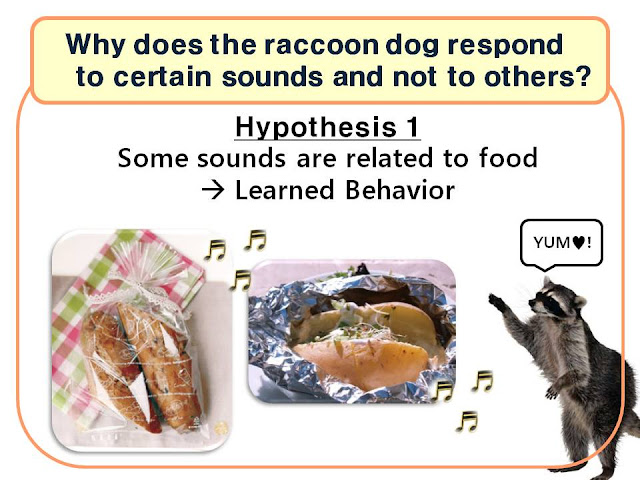While we were observing the raccoon dog, we noticed that it responded to different sounds differently. The raccoon dog was exposed to many different kinds of sounds, including the sound of a bicycle rolling by, a plastic bag cackling, a motorcycle engine sound, and a tuna can clanking on the ground. To these various sounds the raccoon dog responded only to some, by looking up, and to others it did not pay any attention.
So we made a question about this behavior: why does the raccoon dog respond to certain sounds and not to others?
Our first hypothesis is that some sounds are related to food. Such as the crumpling sound of the plastic bag or the sound of aluminum foil may have led the raccoon to relate the sounds to food source. Perhaps, life in KAIST may have caused to raccoon to display learned behavior.
The test to this is by comparing the behavior of KAIST raccoon dog and a wild raccoon dog that has not been exposed to human food sources. If the wild dog also responds to the sounds of plastic bags and can clinging as much as it responds to bicycle or motorcycle noises, then our hypothesis will be proved correct à the raccoon is displaying learned behavior
Our second hypothesis is that the raccoon dog responds to sounds that it considers more threatening. However this hypothesis is not convincing in that usually sounds of motorcycles are more threatening than the sound of plastic bags.
However, if you remember the raccoon dog that was road killed- the location was in front of 정문술 building where there are a lot of cars and motorcycles. Perhaps, the raccoon dog is insensitive to motorcycle sounds.
Our last hypothesis is that the raccoon dog responds to different sounds in its audible frequency range, and responds sensitively to some frequencies. For example, fire alarms or the horn clanking of cars are designed to alert humans for maximum attention in frequencies we are most sensitive to.
Perhaps for raccoons, these high pitched frequencies are their most sensitive areas. So, for this hypothesis, we designed two experiments.
First, we can use the AEPs (Auditory evoked potentials) method which allows us to represent the response in the brain according to sounds in different frequencies by recording the very small electrical voltage potentials originating from the brain and recorded from the scalp in response to auditory response.
This is the usual auditory pathway of a raccoon dog which is similar to dogs. Through following the pathway of the auditory response to the last step, recognition and response from the cortex of the brain, we can observe the intensity of the raccoon dog’s response to different frequencies.
Then we can take the above procedure to obtain the information about the neural patterns of the raccon dog's brain in response to certain sounds.
Another experiment would be a behavior test, which checks the audible range of the raccoon dog. By exposing the raccoon dog to sounds of different frequency, we can see how it responds to certain frequencies.










댓글 없음:
댓글 쓰기